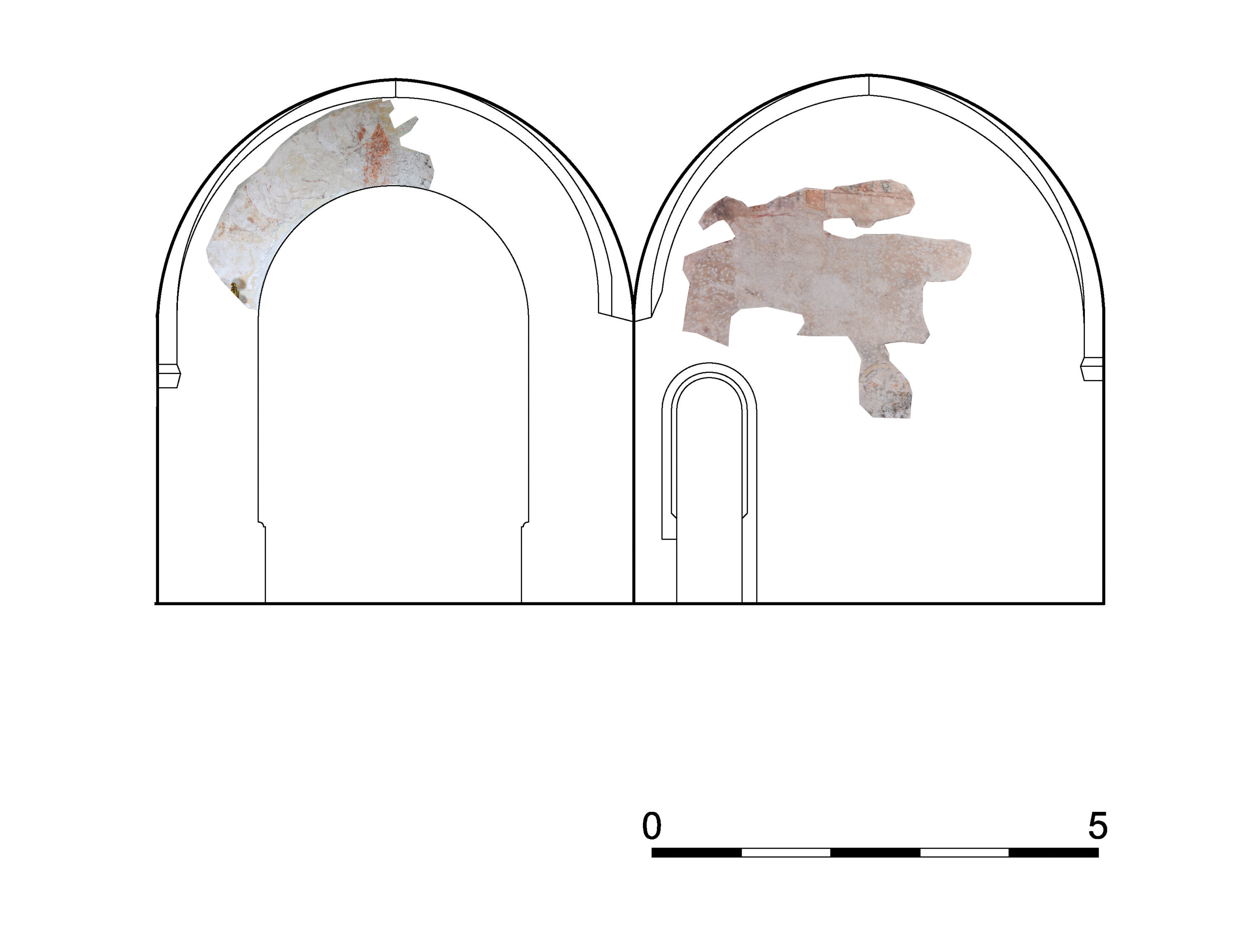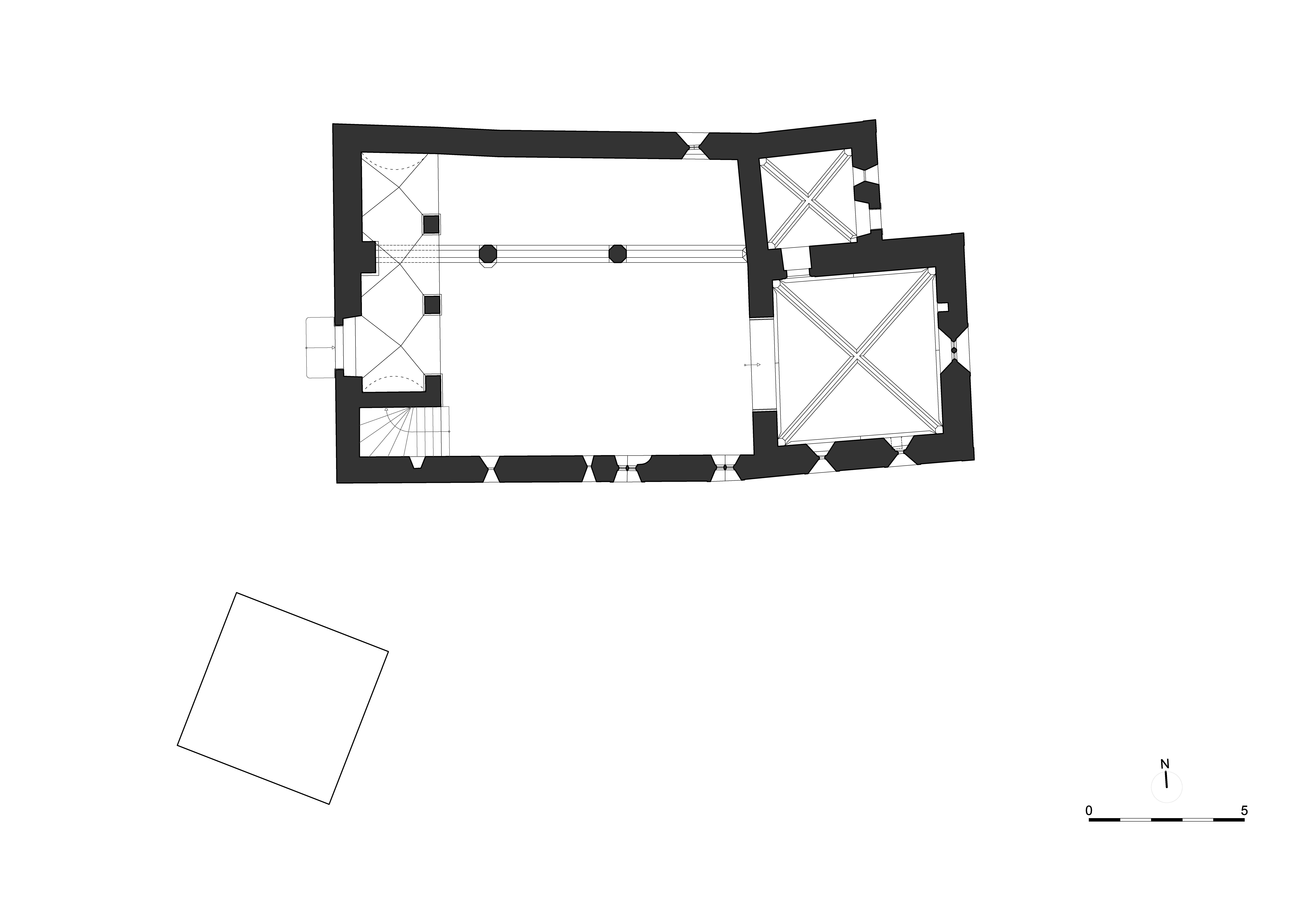









The fragment on the northern interior wall of the chancel depicts a low wall with a door on the left side. The bright wall is made of properly stacked bricks with pronounced grout joints painted in reddish colour, while the door is light brown. Behind the wall is a barely noticeable group of people, of which the figure on the right is slightly more visible; it appears to be extending its arm from under a greenish cloak. Individual reddish lines and paint stains suggest that the scene continued to the left of the door, but we can only speculate as to its content.
The scene on the southern part of the triumphal arch towards the chancel is better preserved. As it is, the northern part of the chancel’s triumphal arch is still covered in whitewash, and a small fragment only reveals an outline of the left shoulder of a probably naked and long-haired person. The almost entirely preserved scene on the southern side shows a larger reclining nude figure on the lower left. It is facing left, and only its outlines have been preserved. Apart from the light colour of the body, the fact that the figure is naked is indicated by the outline of its abdominal muscles in particular. Its right hand is under its face, and its left rests on its right shoulder. The face is completely indistinguishable, but the figure probably had short light brown hair. Two slightly smaller figures are also noticeable on the right side. On the right is a standing figure in a red cloak, facing left. Its right arm is raised in blessing, while its left arm is stretched forward with the palm facing upwards (the hand is drawn incorrectly, as the thumb is on the inside). The head is entirely indistinguishable. A third figure is partially preserved in the centre of the scene. Only the outlines of the upper part of the body are visible: the figure is also naked, holding its arms in front of its chest. The head is once again very poorly preserved, but it is obvious that long light brown hair falls on the figure’s shoulders.
A bordure consisting of interlaced reversed heart-shaped loops in yellow, green, and red has been partially preserved on the ribs along the northern and southern walls. The yellow stars on the ceiling and the consecration cross may also originate from this stage.
The only surviving parts of the mural, which originally probably covered the entire chancel, include the two fragments on the northern wall and the southern part of the triumphal arch, as well as the bordures on the ribs in the southern and northern parts of the vault. The preserved fragments are severely damaged and mostly only visible in their outlines, while the northern part of the triumphal arch remains under a more recent layer of whitewash. The state of the Christ on the Cross fragment on the exterior is similar.
The poor state of preservation makes stylistic analysis very difficult, but the relatively subtle drawing points to the late Romanesque or early Gothic period.
The interior murals could have been painted shortly after the addition of the chancel, i.e. still in the 13th century or in the second half of the 13th century.
An unknown painter.
Only the scene on the southern side of the triumphal arch can be identified with certainty. It is a representation of the Creation of Eve as described in the Bible (Genesis 2:21–25). The reclining figure represents the sleeping Adam, from whose rib the Lord God, wearing a red cloak on the right, created Eve. Eve receives God’s blessing with her arms raised in orant pose.
Janez Höfler assumes that the preserved murals once represented the story of the Original Sin. The Creation of Eve scene could be followed on the right by the portrayal of the Original Sin, as confirmed by the preserved fragment of a naked figure with long hair – Eve by the Tree of Knowledge – while on the southern wall, the group behind the wall could represent a part of the Exodus from Paradise.[1]
________________________________________
[1] HÖFLER 2001, p. 179.
The church was under the patronage of the Lords of Svibno, who, with their connections, could probably have provided a relatively high-quality painter. Given that Svibno maintained strong ties with Styria at that time, the painter may have come from there.
Pigments: white lime, yellow earth, red earth, green earth, organic black, lead white (?)
Analytical techniques: OM, XRF
The plaster is exceedingly hard; it may have been consolidated during the restoration works, and it was undoubtedly also additionally reinforced by the plaster for the newer mural, applied over the older one. In the cross-sections of all the samples, the painting base is bright, made of lime and large translucent aggregate grains, sometimes slightly pinkish in colour (Fig. 1). The aggregate probably consists of crushed limestone or quartz, but it was impossible to carry out chemical analyses. XRF analyses have revealed considerable calcium (lime) and iron content with a bit of manganese (sand). It seems that some lead pigment, probably lead white, was also added to the plaster, which has not yet been detected in any other medieval murals in Slovenia. Perhaps this was an older restoration intervention from before the end of the 19th century when this toxic pigment was still in use.
The colours of the preserved mural surfaces suggest the use of natural inorganic pigments such as white lime, yellow and red earth, green earth, and some organic black. This is also confirmed by the colour and shape of the pigment grains in the colour layers, as seen in the cross-sections of the samples taken. The XRF analyses of the collected samples have identified yellow and red earth (iron) and umber (manganese, iron), which was added to the pink colour made of white lime and red earth. The yellow colour is also a mixture of several pigments (Fig. 2): apart from yellow ochre, there are also red and black particles, namely red earth and some organic black pigment. In all the samples, XRF techniques have also shown a modest presence of lead, which, however, is more strongly evident in the plaster; lead white may have been added to the plaster, which has not been detected in any other medieval murals in Slovenia until now. A grey-black background can be seen around God the Father on the triumphal arch; perhaps the azurite has blackened and the background was originally blue. Due to the high position of the painting, no samples could be taken. The binder for the pigments is lime from the plaster.
Only the basic colour layers have been preserved. The modelling has mostly fallen away: it can only be detected in some of the folds of God the Father’s red mantle. The basic colour layers were painted al fresco, i.e. on a fresh support. The cross-sections show lime passing into the colour layer and binding the pigment particles together.
A prominent dark red underdrawing is clearly visible on the triumphal arch wall (Fig. 3). All of the figures are decisively outlined with it. In some places, the black final contour that was drawn over it has been preserved. It is possible to discern large hands with long parallel fingers. Most of the figures on this wall have lost their colour surfaces, which, however, have survived on the draperies of God the Father and the figures above the painted wall on the northern side of the chancel. These are the local tones in the colours selected for the tunics and coats: red, green, and blue. There are no underpaintings, or they have not been preserved. The applications of darker folds only remain visible on the mantle of God the Father (Fig. 3) and in some parts of the draperies on the northern wall, such as the blue mantle with a bowl-shaped fold. The painter mostly used broad brushes, though the softness of the colour modelling can no longer be assessed due to the poor preservation of the mural.
Svibno, Parish church of the Exaltation of the Holy Cross, Stage 1 (Svibno), 2024 (last updated 2. 9. 2024). Corpus picturarum muralium medii aevi, https://corpuspicturarum.zrc-sazu.si/en/poslikava/phase-1-svibno/ (3. 4. 2025).
Legal Terms of Use
© 2025 ZRC SAZU UIFS, Corpus picturarum muralium medii aevi
ZRC SAZU
France Stele Institute of Art History
Novi trg 2
1000 Ljubljana


The below list details the cookies used in our website.
| Cookie | Type | Duration | Description |
|---|---|---|---|
| _ga | Non-Necessary | 2 years | This cookie is installed by Google Analytics. The cookie is used to calculate visitor, session, camapign data and keep track of site usage for the site's analytics report. The cookies store information anonymously and assigns a randoly generated number to identify unique visitors. |
| _gat | Non-Necessary | 1 minute | Google uses this cookie to distinguish users. |
| _gid | Non-Necessary | 1 day | This cookie is installed by Google Analytics. The cookie is used to store information of how visitors use a website and helps in creating an analytics report of how the wbsite is doing. The data collected including the number visitors, the source where they have come from, and the pages viisted in an anonymous form. |
| cookielawinfo-checkbox-necessary | Necessary | 1 year | This cookie is set by GDPR Cookie Consent plugin. The cookies is used to store the user consent for the cookies in the category "Necessary". |
| cookielawinfo-checkbox-non-necessary | Necessary | 1 year | This cookie is set by GDPR Cookie Consent plugin. The cookies is used to store the user consent for the cookies in the category "Non Necessary". |
| CookieLawInfoConsent | Necessary | 1 year | The cookie is used to store the summary of the consent given for cookie usage. It does not store any personal data. |
| PHPSESSID | session | Time of session | Cookie stores information about the user's session and allow users to keep their entries during the time of visiting the website. |
| pll_language | Necessary | 1 year | This cookie is used to remember any selection a user has made about language. |
| show_preloader_once | Necessary | Session | With this cookie we remember the user's first visit. |
| viewed_cookie_policy | Necessary | 1 year | The cookie is used to store whether or not you have consented to the use of cookies. It does not store any personal data. |